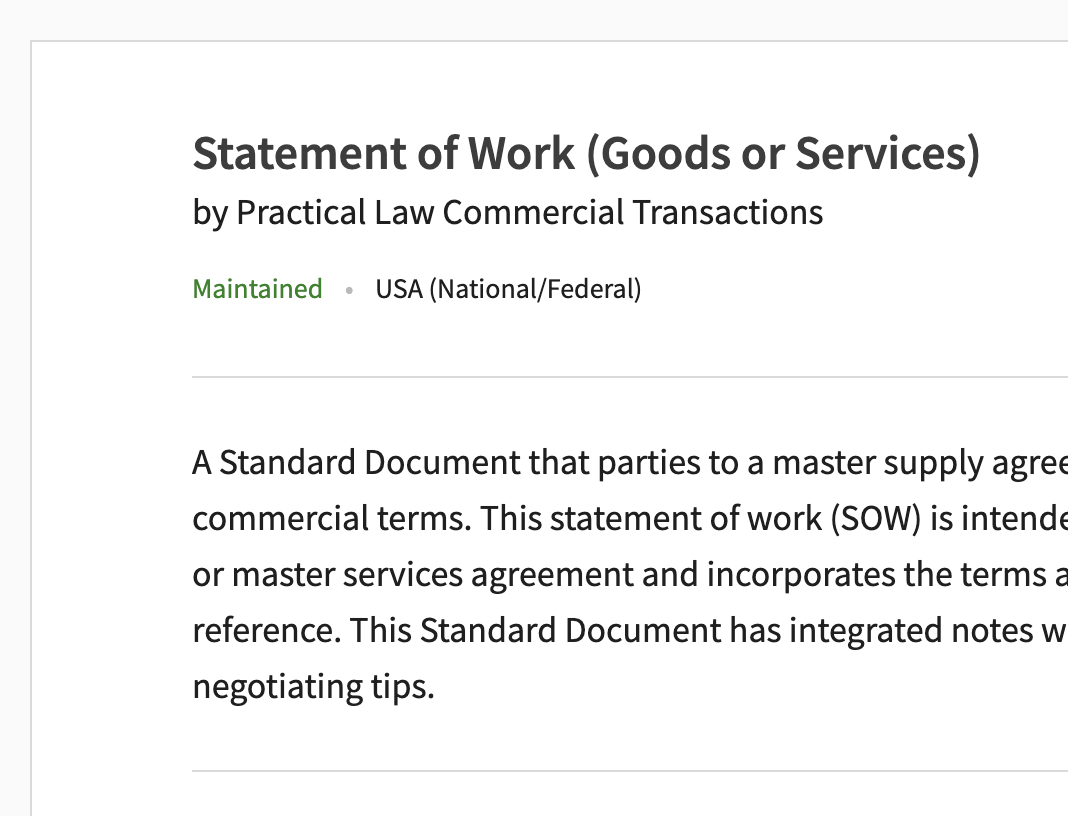Definition, risks, templates and more resources for attorneys
Legal terms • contract • statement of work (SOW)

CoCounsel
Bringing together generative AI, trusted content, and expert insights for contract review and drafting
Meet your AI assistant ↗Jump to ↓
| What is a SOW? |
| What does a SOW do? |
Comparison with Scope of Work and Master Service Agreement
| What are some risks of a SOW? |
| What should be included in a SOW? |
| Templates and more resources |
What is a statement of work (SOW)?
A statement of work (SOW) is an important document that outlines a project’s scope, timeline, and cost between two parties – usually a customer and a supplier.
Its purpose is to ensure all parties have a shared understanding of the expectations and responsibilities associated with the project. A well-drafted SOW not only clarifies roles and responsibilities for both the customer and supplier, but it can also help reduce disputes and promote better budgeting and cost control. It also allows for quick modifications to accommodate changes in the scope of work or project management.
The SOW is a powerful tool for businesses, municipalities, and individuals looking to facilitate a working relationship with one another. It usually contains all the terms, objectives, and timelines of a particular project, Often, a statement of work is deployed when two independent parties, where one party is non a part of the internal workforce of a company, desire to work together toward the mutual completion of a work project or goal. The document, which can vary in size and complexity, provides important details for the actual tasks needed to reach that mutual goal. An SOW is often seen as an essential component of any contract because it sets clear expectations for both customers and suppliers alike. Having a detailed plan in place can help to reduce unexpected costs or delays due to misunderstandings throughout a project’s life cycle. Additionally, it can protect both customers and suppliers if any issues arise throughout the project.
Having a thorough understanding of what goes into creating an effective statement of work is paramount when entering into negotiations with suppliers or customers about any potential projects they may work on together. It’s important for each party involved to review their respective roles outlined within this document thoroughly before signing off to ensure they’re comfortable with all aspects outlined within it before committing themselves legally speaking – either financially or otherwise – to its contents.
What does a SOW do?
As a crucial document, a statement of work outlines the services, deliverables, and expectations between two parties involved in a project.
It should be written in plain language to ensure mutual understanding and provide clarity on project scope, timeline, payment terms, quality standards, staff resources needed for completion, legal obligations for both sides as well as any other agreed conditions. The document may be drafted by either of the parties, however, in most cases, it is drafted by the party with the higher bargaining power. This document helps reduce disputes by setting expectations from the start and allows for budgeting and cost control since it sets out details related to all costs associated with the project upfront. Signing off on the SOW before work commences ensures transparency throughout its duration by providing clear communication protocols between both sides to avoid future issues.
Largely, these contract agreements are effectively implemented when one company requires the services of another. The State of Oregon’s SOW Writing Guide offers some particularly helpful insights into the document and its drafting process.

White paper
Smarter about Contracts: Bringing a system of intelligence to contract lifecycle management
Access white paper ↗While each SOW will ultimately be shaped by the unique circumstances necessitating it, there are naturally going to be some areas of overlap between contract agreements. However, in many cases, a statement of work template is followed to usher consistency, avoid ambiguity, and save time for projects that are of a similar type and between identical/similar parties. In order to create a statement of work that covers all the major requirements, consider these tips from the Texas Department of Information Resources, the basic elements of each statement should generally include the following components:
- Size of the project
- Responsibilities and roles for each party
- Needed deliverables
- Schedule/Performance period
- Level of service expectations
- Criteria acceptance expectations
Additionally, certain projects may require other more specific considerations, for example, security standards for projects dealing with sensitive data or eligibility requirements, if applicable.
Benefits of drafting an SOW
A well-drafted SOW can have several benefits for the completion of the project and the parties involved. Here are the main advantages:
Less risk — With proper planning and division of obligations/responsibilities with a SOW there is less risk of overrun and disputes.
Budget control — With an SOW the parties agree upon a proper cost structure before commencing the project taking into account any cost assumptions. Additionally, a fixed cost is paid, although in installments in some cases, rather than a salary.
Prevents increase in the scope of work — Projects often cost overrun due to changes in the scope of work or constant revisions in the plans. A well-drafted SOW prevents this by clearly defining the scope of work and the timelines involved.
Collaboration with the outside workforce — The key management personnel of the vendor and the customer can collaborate and oversee the project. This is only possible in the case of a well-drafted SOW where acceptance criteria and location of operations are not only clearly defined but also agreed upon by the parties involved in a binding document.
Statement of Work vs. Scope of Work vs. Master Agreement
There is certainly no shortage of ways to engage in a business relationship, and many of the avenues available to parties entering a work-related negotiation share some basic similarities. However, different vehicles may generally have different purposes. With respect to these contracts, the specific terms, clauses, and other designated responsibilities included will depend on exactly what vehicle a business and vendor chooses.

Practical Law Clause Finder
Gold-standard clauses and trusted language for your agreements within Microsoft Word
Try Clause Finder ↗Master Service Agreement (MSA)
The statement of work is a sharper document than, another type of business contract, the master service agreement (MSA), which has become an increasingly popular process for business contracting.
While MSAs are the broad, foundational contract arrangements that outline the relationship between entities working with one another, the SOW is a far narrower agreement. A statement of work is often attached or appended to a master service agreement.
Scope of Work
Additionally, it is helpful to explore another key distinction between the Statement of Work and a similar-looking instrument: the “Scope of Work.” While the SOW is narrowly tailored to a specific project agreement, the Scope of Work is quite different. The scope of work helps to ensure that the product or service meets the documented needs and establishes the parameters of what could be included or amended into the resulting contract.
As such, those parameters represent an important element of the contracting process as they are necessary to ensure a vendor understands what is being asked, assess their own capabilities and performance, and ultimately decide if they, can, and most importantly want to, enter into such an arrangement.
Request for Proposal (RFP)
Furthermore, another document is used in conducting business. A Request for Proposal (RFP) is a preliminary step that is used to invite proposals/bids from prospective vendors for a project.
A request for proposal or RFP is different from a statement of work in the sense that a RFP invites proposals in which the vendor provides the skills and experience that they possess, and the party requesting sets out details of the terms of the contract along with the evaluation criteria. On the other hand, a statement of work is usually the next step to an RFP. After a project is awarded to a vendor, a statement of work is made to detail the work/obligations involved in a project.
What are some risks of a SOW?
While a statement of work can be an effective and powerful contracting tool, there are naturally some traps and pitfalls counselors will want to watch out for while drafting the documents. Understanding where these agreements fall short can be immensely helpful when considering how to craft an effective one.
The most common risk is misalignment between expectations due to an inaccurate SOW. If the SOW does not accurately reflect what is expected from both parties, it can lead to confusion and disputes down the line. All parties need to ensure that the document is as clear and concise as possible before any work begins.
Additionally, another common mistake cited in the cautionary piece is signing off on an SOW that doesn’t specify how many revisions a client can ask for when delivering the work. For vendors, this can be a major time drain if a client is uncertain about what they want their final product to look like. Revisions are a part of any major project, but so are reasonable, cost-effective expectations.
Another common risk is insufficient information to evaluate pricing and delivery schedules. If the statement of work does not contain enough detail about what services or materials will be needed, then it can be difficult to determine how long a project will take and how much it will cost. This can lead to delays in completion or unexpected costs that could have been avoided if more information was included in the SOW.
It’s also important for both parties to sign off on an SOW before any work begins as this makes it legally binding on both sides. Failure to do so could mean that one party has no legal recourse should things go wrong further down the line.
Finally, there is also a risk of assigning responsibility or risk inappropriately when creating an SOW. It is of paramount importance for all parties involved to understand exactly who holds responsibility for different outcomes related to a project – such as timelines, budgets, quality standards, etc. — otherwise, one side may end up bearing more responsibility than intended resulting in potential disputes down the line.
So, when creating and signing an SOW, it’s essential that all parties understand their roles and responsibilities clearly and that any risks associated with the project are addressed upfront in order to minimize potential disputes later down the line.
Types of SOWs
There are several different types of SOW documents available, each with its own advantages. The three main types of statement of work agreements are design, level of effort, and performance-based SOWs.
Design: Design SOWs are focused on the design and development of a product or service. They outline the specific tasks related to design, such as research, prototyping, and testing. The contractor is responsible for delivering a design that meets the client’s requirements, and the SOW typically includes milestones for design reviews and approvals.
Level of Effort: On the other hand, the level of effort SOWs (also known as time and material) involve payment based on hours worked plus any materials used in completing the work. This type of agreement may be preferable and flexible if you’re unsure how long a project will take or what resources will be needed to complete it.
Performance-Based: Performance-based SOWs are focused on the outcome of the project. They outline the objectives and goals of the project, and the contractor is fully responsible for achieving those goals This type of SOW is often used when the project outcome is more important than the process used to achieve it.
What should be included in an SOW?
A statement of work includes all elements necessary for successful project completion, including the scope of the work to be done and what is not included; the timeline of when the work is to be completed; and any applicable legal or regulatory requirements.
Additionally, an SOW should include details regarding deliverables required from the contractor, payment terms between both parties, and quality standards. Here’s a full list:
- Governance
- Scope of Work
- Deliverables
- Timelines
- Cost of Project(s)
- Additional Project Requirements
- Overview of Project
The scope of work defines exactly what needs to be accomplished for the project to be considered complete. This includes services or tasks that must be completed, as well as those which are outside of the scope and will not be fulfilled by either party. The timeline sets deadlines for each task or milestone and outlines when payment will be made for those milestones. It is important that this timeline is clear and realistic so that all involved understand expectations around completion dates.
The timelines should also include the effective date and expiration date of the statement of work. The dates should not conflict with the master service agreement, if one has been entered between the parties.
The SOW should also include deliverables that must be provided by contractors or suppliers in order for payment to occur. These could include reports, materials produced, documents created or signed off on — any document that provides evidence that tasks have been completed successfully within agreed timelines. Payment terms should also outline how much will need to be paid at each stage or milestone completion in order to ensure timely payments are made throughout the process.
Finally, quality standards should also form part of an effective SOW in order to provide clarity on expectations around service delivery and performance metrics used to measure success. This can help both parties remain focused on delivering high-quality results while avoiding disputes where possible through mutual understanding around expected outcomes from each party involved in the project.
Outlining these key elements within an SOW before the commencement of a project helps ensure greater transparency between both parties while reducing potential disputes due to misunderstandings about roles and responsibilities throughout its duration.
While each agreement will inevitably vary based on a wide range of variables, some examples of existing contracts do highlight some key characteristics worth considering. Next is a case study focused on SOW elements.
Case Study: U.S. General Services Administration
The U.S. General Services Administration offers a convenient template with lots of useful information about what types of components would be most beneficial to include in an SOW. Included in its template is a 28-point list of clauses detailing the various sections legal teams would be expected to generate and consider.
Of note are sections dedicated to the specific tasks a vendor would be expected to perform, in addition to a section for optional tasks, a delivery schedule, personnel, resumes, invoicing, travel, privacy, and data.
The “Contract Management Plan” sub-section and the “Quality Control Plan” sub-section under the broader “Deliverables and Delivery Schedule” highlights some of the critical language an SOW generally includes. For example, consider the contract management segment: “Contract Management Plan – The Contractor shall prepare a draft and final Contract Management Plan specifying the tasks, sub-tasks, and approaches to be used to provide the services and products specified including the deliverable documents, analyses, and reports necessary to fulfill the requirements of this SOW. This Plan shall be delivered in the draft not later than one week following the award of the Contract.”
Similarly, the quality control clause features language nearly mirroring the contract management segment. For procurement, both sections put the duty of responsibility on the contractor to draft the needed documents and outline the necessary components for the arrangement to succeed.
“Quality Control Plan – The Contractor shall prepare draft and final versions of a Quality Control Plan specifying the tasks, sub-tasks, and approaches to be used to ensure adequate quality and integrity of work developed. This Plan shall be delivered in the draft not later than one week following the approval of the Contract Management Plan.”
How to write an SOW
Creating a statement of work is an important step in guaranteeing successful project execution. It should offer lucidity on the reach, timeline, and expenditure of the venture while additionally specifying the obligations and duties of all partners included. Taking the necessary steps to guarantee that your SOW is clear and exhaustive is essential. Here’s the structure that may be included in your SOW:
- Introduction
- Purpose
- Scope of Work
- Performance Period
- Location of Operations
- Task and Milestones
- Standards
- Scheduling and Due Dates
- Monitoring
- Acceptance Criteria of the project
- Terms of Licensing
- Indemnification
- Representation and Warranties
- Intellectual Property Rights, if any
- Termination
- Delegation, including sub-contractors and permitted delegation
- Defining Project Success
- Payment Model
The initial phase in composing an SOW is to characterize the extent of work for the task. This incorporates referencing its reason, results, schedule, and spending plan. Guarantee that you incorporate all pertinent subtleties such as installment terms, landmarks, and revealing necessities. Affirm that both parties (including any important stakeholders) have an unmistakable understanding of what’s anticipated from them before continuing with any legitimate records or agreements.
At that point, it’s important to assign jobs and responsibilities for everyone associated with the undertaking with the goal that there are no false impressions or miscommunications later on. Demonstrate unmistakably who will be liable for which errands to accomplish fruitful completion inside a given time limit and spending plan range.
With every one of these points characterized it’s an ideal opportunity to make legally binding archives that can be checked by both sides before being marked off upon. This may include confidentiality arrangements, risk allocation understanding, and proprietorship rights tasks if intellectual property is engaged with the task just as some other extra terms relying upon your particular needs. It’s likewise critical to refresh these reports during various stages of venture advancement if changes are made in scope or timetable — this will help diminish debates between both parties further down the line.
An SOW requires thoroughness in order to set up clearness between all parties involved while reducing potential disagreements due to miscommunications or misunderstandings further down the line. If a price is based on an assumption related to overtime or the price of a good, then that should be mentioned clearly.
By taking care in delineating each part required preceding marking off on any legal document or contract you can ensure productive completion within budget while limiting any risks related to working together as two separate entities.
Templates and more resources
Ultimately, a statement of work can be a powerful tool that helps complete projects efficiently while staying within budget. Having an effective SOW is critical for successful project completion.
Templates
A statement of work template is a pre-set format that is used to create a statement of work. It may be used to bring consistency between statements of work for different projects of the same customer. Further, all terms in a statement of work must be defined clearly to ensure that the parties do not have multiple interpretations.

Practical Law Standard Document
Integrated notes with important explanations and drafting and negotiating tips
Access with free trial ↗Below you’ll find more resources such as a template, or Standard Document, that parties to a master supply agreement can use to set out transaction-specific commercial terms. This statement of work (SOW) is intended to be attached to a master sale of goods or master services agreement and incorporates the terms and conditions of the master agreement by reference. Standard Documents contain integrated notes with important explanations and drafting and negotiating tips.
Practical Law’s resources are written and maintained by over 650 dedicated full-time attorney-editors globally. They’re highly qualified, having practiced at the world’s leading law firms, corporate law departments, and government agencies, so they understand the challenges you face and are dedicated to creating resources to help you navigate the new legal realities, legislative changes, and practice areas impacting your clients or organization.
Related templates by Practical Law
- Statement of Work (Goods or Services) ↗
- Software Development Master Agreement (Pro-Customer) ↗
- Professional Services Agreement ↗
- Services Agreement (Pro-Customer) ↗
- Service Level Agreement ↗
- Patent Litigation: Claim Construction Considerations (Patent Owner) ↗
Practice notes
In addition to Standard Documents, attorneys can explore Practical Law’s Practice Notes below. For example, a Practice Note about government contracts offers practical guidance for federal agency counsel for reviewing a solicitation for a procurement. The Note discusses the parts of the solicitation and the associated points of review. The Note also contains information about the contract line item numbers (CLINs), statement of work (SOW), instructions to offerors, and evaluation criteria.
Related Practice Notes by Practical Law
- Government Contracts: Reviewing a Solicitation ↗
- Registration Statement: Form S-1 ↗
- Proxy Statements ↗
- Copyright: Overview ↗
- Work Product Protection: Overview (Federal) ↗
- Drafting and Negotiating an Effective Statement of Work ↗
Disclaimer
The content appearing on this website is not intended as, and shall not be relied upon as, legal advice. Although this content was created to provide you with accurate and authoritative information, it was not necessarily prepared by attorneys licensed to practice law in a particular jurisdiction. It is general in nature and may not reflect all recent legal developments. Thomson Reuters is not a law firm and an attorney-client relationship is not formed through your use of this website. You should consult with qualified legal counsel before acting on any content found on this website.










